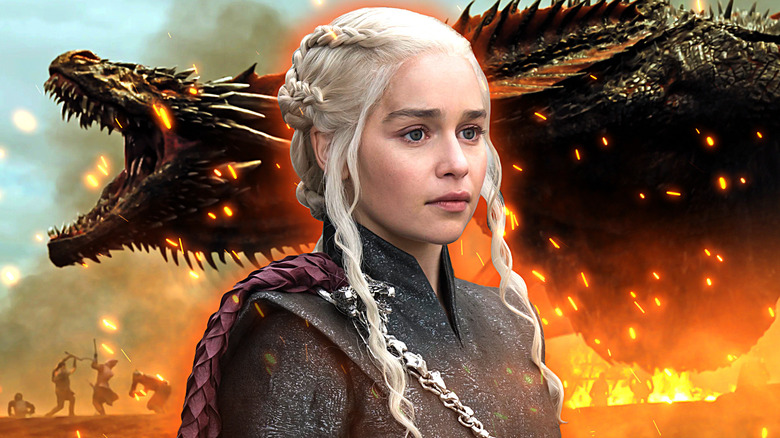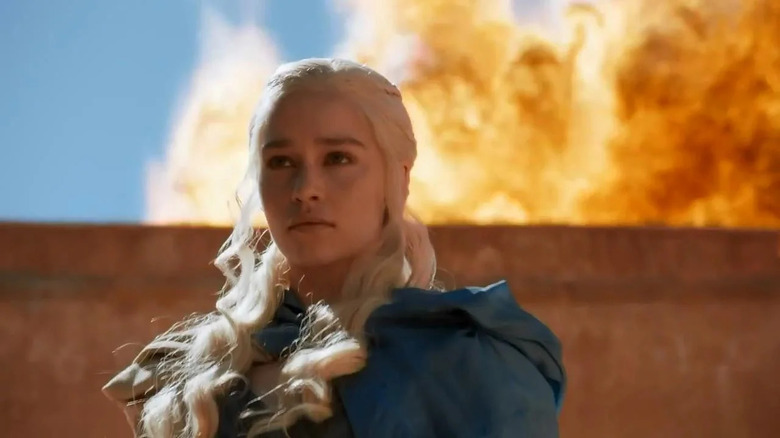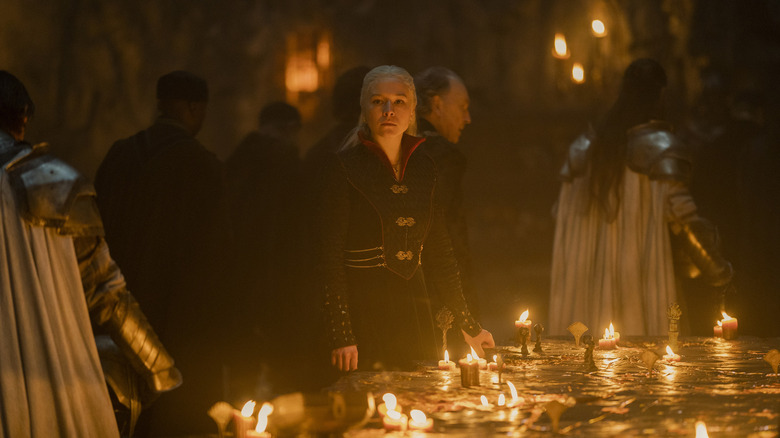Game Of Thrones: Are Targaryens Actually Immune To Fire?
No, Targaryens aren't technically immune to fire — but the on-screen depictions play fast and loose with that reality sometimes.
At the end of the Season 1 finale of "Game of Thrones," Daenerys Targaryen, played by Emilia Clarke, sets fire to her husband Khal Drogo's (Jason Momoa) funeral pyre before entering the flames herself, three dragon eggs in tow. Her allies, including her loyal knight Jorah Mormont (Iain Glen), are horrified ... and then amazed when, at daybreak, Daenerys emerges nude from the smoke with three tiny, newly hatched dragons in her arms. So does this mean all Targaryens can do this?
In an archived chat with "A Song of Ice and Fire" author George R.R. Martin from March 1999 — long before the TV series was even a shared twinkle in David Benioff and D.B. Weiss' eyes — Martin was asked to confirm if Targaryens are simply immune to fire, specifically once they form a bond with their dragons.
"Thanks for asking that," Martin responded. "It gives me a chance to clear up a common misconception. TARGARYENS ARE NOT IMMUNE TO FIRE! The birth of [Daenerys]'s dragons was unique, magical, wonderous, a miracle. She is called The Unburnt because she walked into the flames and lived. But her brother sure as hell wasn't immune to that molten gold." (Martin added that Daenerys probably wouldn't survive another funeral pyre.) Here, Martin is referring to Daenerys' brother Viserys III Targaryen (Harry Lloyd), who is killed by Khal Drogo with a vat of molten gold poured over his head — but it should be noted that Daenerys casually walks out of fiery situations more than once on "Game of Thrones."
Throughout Game of Thrones, Daenerys frequently utilizes fire as a weapon
Once Daenerys' three dragons — Drogon, Rhagael, and Viserion — grow larger and stronger, the self-named "Mother of Dragons" uses them as a sort of "deus ex machina" to get out of any sticky situation (a "draco ex machina," if you will). In Season 2, her dragons are stolen during a visit to the mystical city of Qarth; to get them back from the warlocks who took them, Daenerys must enter the House of the Undying, where she ultimately sets the warlocks ablaze to save her "children." Memorably, in Season 4, she agrees to sell her largest dragon Drogon to the odious slave trader Kraznys mo Nakloz (Dan Hildebrand) in exchange for his enormous Unsullied army. Daenerys, as usual, has a plan; as soon as she takes ownership of the Unsullied, she turns on Kraznys and has Drogon barbecue him immediately before torching most of the city as she decimates the other slave masters. There's also the time she torches King's Landing and burns it to the ground in Season 8, massacring countless innocents in the process; that one's not her best use of her dragons, to say the least.
Perhaps most bafflingly in light of George R.R. Martin's comments, however, is Daenerys' conquest of Vaes Dothrak in Season 6. After being captured by a group of khals and identified as Khal Drogo's widow — which classifies her as relatively useless to the khals — an enraged Daenerys assembles all of the khals into one building and burns it down, once again emerging naked and victorious from the flames. Certainly, the show created by David Benioff and D.B. Weiss is different from George R.R. Martin's original books, but based on what he said in 1999, this scene feels a bit confusing.
On House of the Dragon, Targaryens also face fiery consequences
"Game of Thrones" is long gone — the series ended in 2019 with a whimper rather than a bang — but its spin-off and prequel "House of the Dragon" kicks off its second season soon, and so far, none of its Targaryens have faced the exact same fiery trials as Daenerys. Set nearly two decades before Daenerys is even born, "House of the Dragon" chronicles the Targaryen civil war known as the "Dance of the Dragons," which pits Team Black (led by Emma D'Arcy's Rhaenyra) against Team Green (led by Olivia Cooke's Alicent Hightower) in a fight for the Iron Throne. Rhaenyra, as the eldest daughter of King Viserys I Targaryen (Paddy Considine), believes her father meant for her to sit atop the throne; Alicent backs her and Viserys' eldest son, Aegon II (Tom Glynn-Carney), despite Rhaenyra's legitimate claim.
Obviously, all of these people all have dragons — and they actually have more dragons than anyone besides Daenerys has in "Game of Thrones," as the powerful creatures are largely extinct and believed to be fictional by the time the original series begins. (That's a big part of why Daenerys' stunt with the funeral pyre is such a big deal.) Atop dragonback, the characters on "House of the Dragon" wage war against each other, and aside from a moment where a non-Targaryen character self-immolates with her own dragon — Laena Velaryon (Nanna Blondell), who chooses to die by dragonfire rather than during a dangerous childbirth — none of the Targaryens have yet faced the fire themselves. Despite Daenerys' questionable immortality in the face of the flames, we'll have to wait and see if "House of the Dragon" also plays fast and loose with George R.R. Martin's decree.


